Don’t let this topic confuse you. It’s not about building a website from scratch or writing code. The perfect website doesn’t just exist on the Web, it sells and engages.
The topic of today’s SEMrush Chat is what you should tell your web developer to do to improve your results in SERPs and ultimately sell more products.
We’re super excited to hear some practical tips from French SEO rock star Laurent Bourrelly @laurentbourelly and our other chat participants. Without further ado, let’s get started with the first question.

So, you have a brand new website and just start your search optimization project. How can you ensure your website was created taking into account modern search optimization requirements?
A1 2 main concepts : siloing and semantic affinity #semrushchat
— Laurent Bourrelly (@laurentbourelly) 20 января 2016
In SEO, “the term siloing originated as a way to identify the concept of grouping related information into distinct sections within a website. Much like the chapters in a book, a silo represents a group of themed or subject-specific content on your site.” ( bruceclay.com)
Using different variations and phrases around your keywords, incorporating long tail keywordss, and writing about topics that are not covered by your direct organic competitors are all techniques for crafting the perfect website.
A1 High quality content. Proper seo kw research and content optimization. Did I also mention lots of high quality content? #semrushchat
— Julia McCoy (@JuliaEMcCoy) 20 января 2016
Content is the king of modern SEO. Doesn’t matter how much you like your content, you need to assess it as unbiased as possible. Does it really meet your goals? Does it perform well in organic search? As Dawn Anderson @dawnieando mentioned, you should read critically and consider opinions.
A1: An @semrush site audit is a great way to evaluate your site's #SEO. #semrushchat
— Tara Clapper (@TaraMClapper) 20 января 2016
Thanks for mentioning us, Tara! Our Website Audit tool gives you detailed information on any optimization issues – from duplicated content to each missed alt tag for each visual on the website.
A1: Have a user first approach, responsive design, pay attention to UX. Work with SEO, not against. #semrushchat
— Andrew Epperson (@eppand) 20 января 2016
Websites that rank well in Google all have one thing in common: they all put the user first, not the product. A website’s navigation and overall comprehensive usability differentiates them from less successful websites.
A1: Don't be one-sided. Embrace both the on-page and technical sides of SEO. Those two working together leads to a great UX. #semrushchat
— Joe Martinez (@MilwaukeePPC) 20 января 2016
To make sure their website meets search engines requirements, marketers should take a user-first approach and spend more time planning user interfaces and coming up with truly responsive designs.
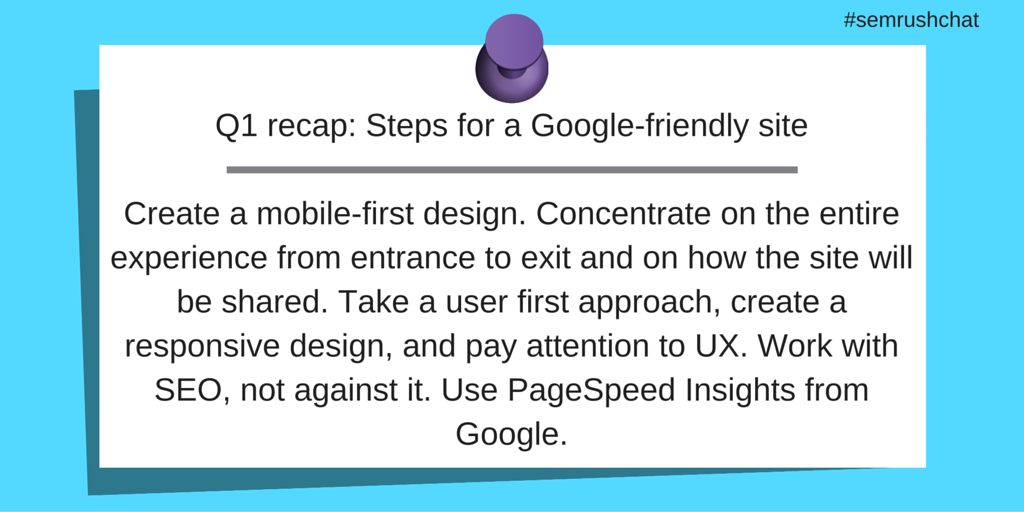
There are a lot of publications on the Web stating that marketers should optimize their site’s structure to achieve success in search results. But only a minority of bloggers care to explain why and how actually do it as a marketer. The next question will shed light on this mystery.

Once we are digging up in the core structure of the website, it’s important to understand that a user-first approach works here as well
A2 One mantra for a great website is: the user is first #semrushchat
— Obed M. (@MrClics) 20 января 2016
The structure of your website should be intuitive and not to allow different interpretations. Pretend that your user is drunk: their attention span is shorter than ever, and their eyes are more focused on the center of the screen, rather than on footer and sidebars. What should you rethink to guarantee the user will have a good time interacting with your website? What will make them buy whatever you’re selling?
A2: Optimize page speed, structured markup (eg. https://t.co/u6CsSUjAqo) opengraph, clean metas, proper HTML semantics. #semrushchat
— Andrew Epperson (@eppand) 20 января 2016
Joe Martinez @MilwaukeePPC adds that a clean, easy-to-use structure will always benefit the user. A design that makes your top products easy to find will benefit your business online.
Essentially, your site’s structure must be optimized to make it simple to use and easy for search engine bots to crawl. This can be achieved by optimizing your page’s speed using schema.org. Plus, marketers should also have clear sales funnels in mind.

Above we talked a lot about website content. It’s clear that producing new, engaging content improves a website’s visibility in SERPs, but is this an endless process? When should a marketer tell their content manager to stop?

Your content strategy is important, but content alone will not help you get enough conversions. You should rethink your site’s core structure and use internal linking to benefit from organic search.
A3 Instead of thinking about a content strategy, think about a linking strategy (internal) #semrushchat
— Laurent Bourrelly (@laurentbourelly) 20 января 2016
Laurent also adds that internal links are used to push specific pages. A good strategy is to think of your pages as link providers. Tim Capper @GuideTwit suggests monitoring user interactions: if your users / customers have stopped asking questions or searching, then you have enough content.
A3: Quality is more important than volume. That said don't forget the 'About us' page :-) #semrushchat
— Omi Sido (@OmiSido) 20 января 2016
Joe Martinez @MilwaukeePPC agrees that there’s no industry standard. Whatever satisfies the user’s search query and is valuable enough that they have to share it with others is best.
So, in the end you should stop creating new content for your site as soon as it is enough to answer all reasonable customer questions concerning your business’ offerings. You should, however, focus on updating your content to provide your users with the most up-to-date information – and to let Google know your'e doing so.
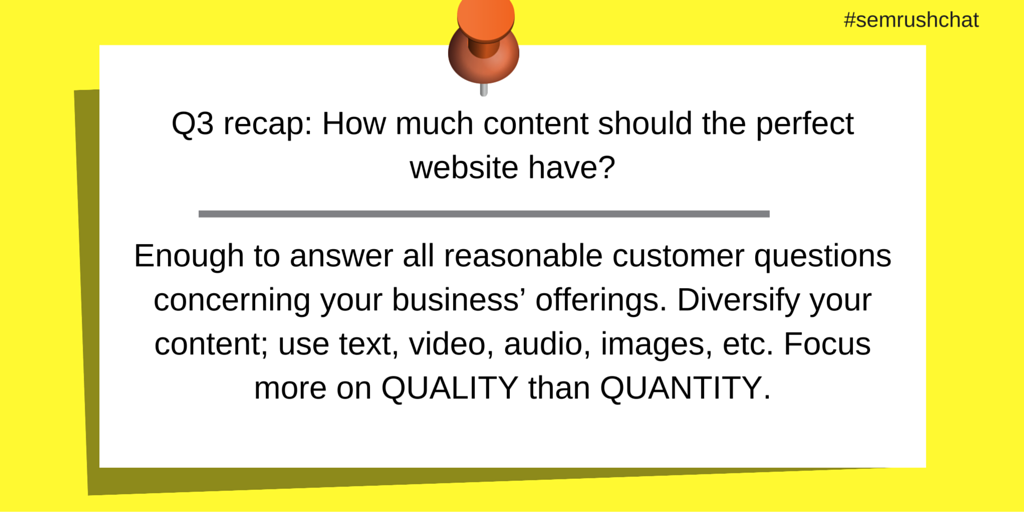
Above Laurent mentioned internal linking as the main tool for optimizing website structure. Let’s get into the details and learn how to use internal linking more effectively.
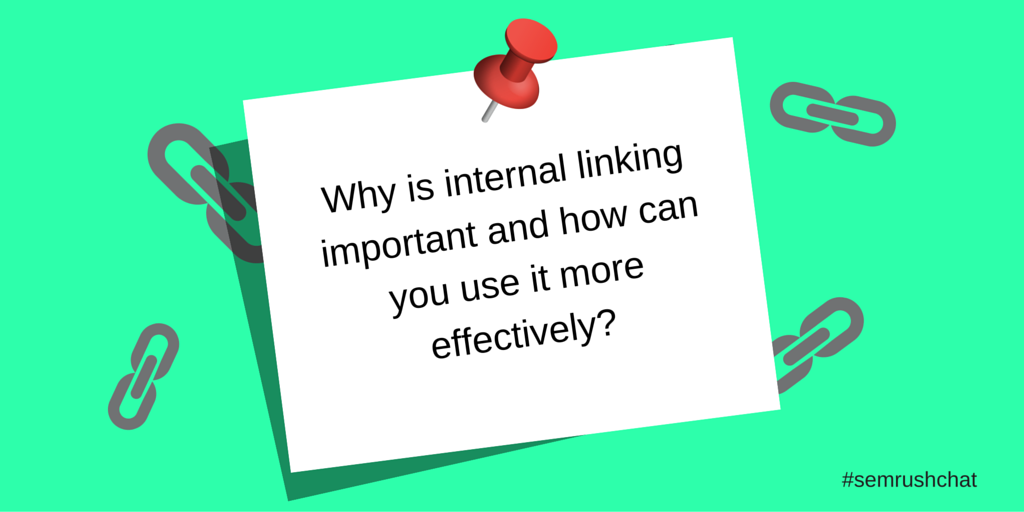
First of all, let’s give a correct definition to ‘internal linking’ term.
A4: Internal linking is like a well-made road map--it gives search engines & users directions for how to move through the site. #semrushchat — Medium Blue (@MediumBlueSEM) January 20, 2016
Note that here we are talking not just about search engines, but also website users – it’s very important, because website owner should keep in mind both, while working on internal linking structure.
G's mission is 2 'organise' web. If it's not organised it's not easy 2 understand. ontology #semrushchat https://t.co/6NoYWr1KVL
— Dawn Anderson (@dawnieando) January 20, 2016
So first of all, website owner should use internal linking for the better website structuring. But, it’s not enough just to provide users with a great navigation – “Making sure users find what they need is just good UX. Use internal linking only when the pages' relationships make sense” - Joe Martinez @MilwaukeePPC.
A4: Internal linking keeps users flowing through your website for greater engagement, while *cough* passing link authority too. #semrushchat
— Jacques Bouchard (@jacquesbouchard) January 20, 2016
Think about your users’ needs – it’s a core principal you have to think about – “Think about what relates most. Images, PDFs, case studies, video, podcasts, courses. To understand this, first understand audience” - Tony Dimmock @Tony_DWM.
A4: Schedule regular content audits to go through old blog posts (that are performing well) and link to new, relevant posts. #semrushchat
— Shawn Harding (@shawnbandv) January 20, 2016
As a result, to use internal linking more effectively, you need to schedule regular content audits and go through old blog posts and link to new, relevant posts.
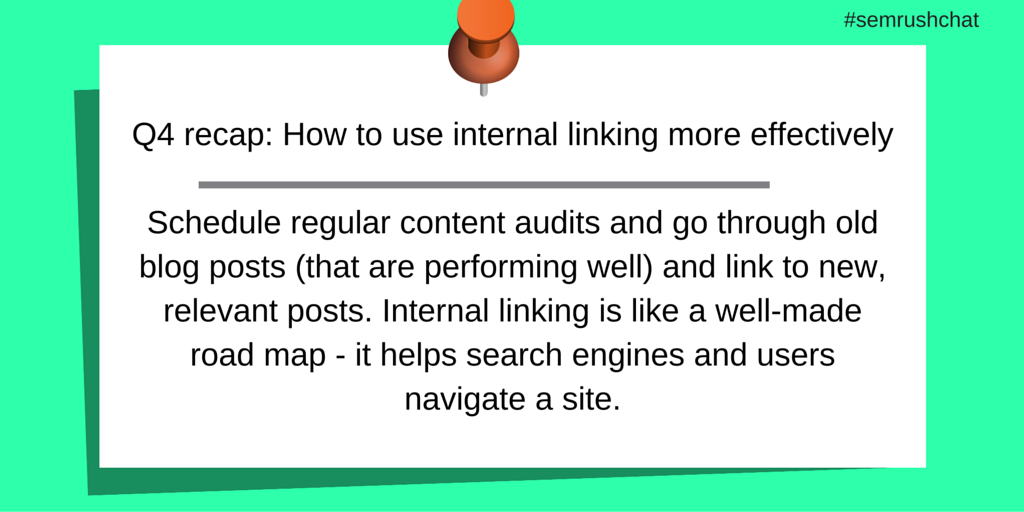
Schema.org is a community that creates, maintains and promotes schemas for structured web data. “On webpages, in email messages, and beyond” as they state on their website. How can implementing schema make your website better?

The main purpose of schemas is to tell a search crawler what kind of information it’s dealing with at the moment. There are a lot of different schemas for each business niche, but communities are still developing in conjunction with search engines.
A5: Use Schema if it actually gets you something in the SERPs like reviews, recipes, etc. Not everything needs to be marked up. #semrushchat
— Patrick Stox (@patrickstox) 20 января 2016
Martin Kůra @HermanTinkura suggests that, besides the obvious benefits, your content will be more easily understood by search engines, which will increases its relevancy — a major ranking signal.
A5 I think schema will not add benefits, but might be a problem if you don't have them in the near future #semrushchat
— Laurent Bourrelly (@laurentbourelly) 20 января 2016
Overall, Schema.org is a great opportunity for local SMBs to benefit from organic search, because implementing Schema markups make your results look more relevant. Plus it’s very important for local business.
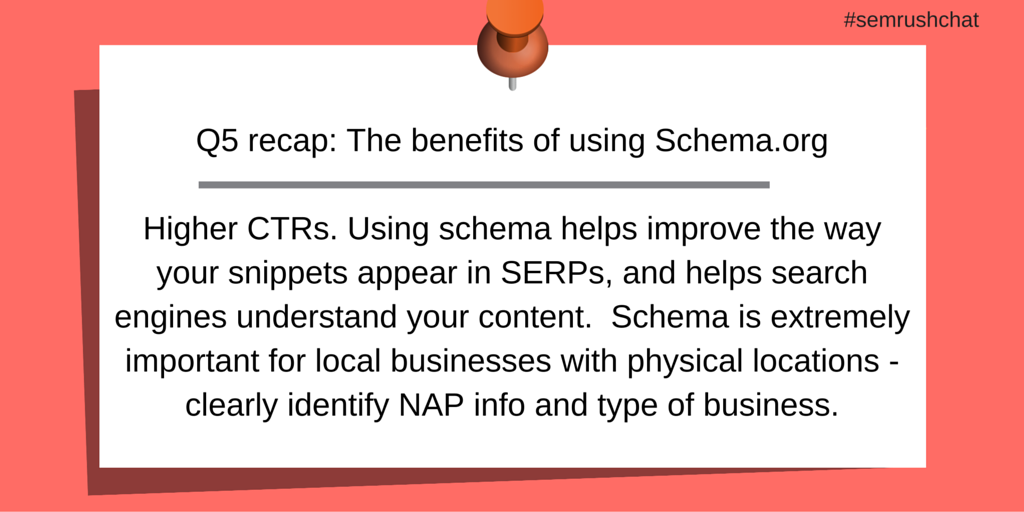

While surfing the Internet, you may wonder what actually attracts people to a certain website. Is it just its design or something else? Let’s find out.
A6: FAST. Good UX design. Visually attractive. Great content. CTA. Keyword topic optimized title, meta, headings and content. #semrushchat
— Lee Germeroth (@leegermeroth) 20 января 2016
Patrick Stox @patrickstox mentioned that all these are a combination of technical on-page elements, site structure, content, UX, and conversion optimization.
A6) Each will depend on the specific consumer, but they all should have 1 overriding factor >> Satisfy the Consumers Intent #semrushchat
— Tim Capper (@GuideTwit) 20 января 2016
But be careful! Laurent warns marketers that no matter how perfect your webpage is, it won’t go far without links – both referral and internal.
A6: Best Anatomy of Web Page: Has Meta Tags, Schema, One H1, High Quality Content, Images, CTA & Social Share Buttons #semrushchat @semrush
— Amel Mehenaoui (@amelm) 20 января 2016

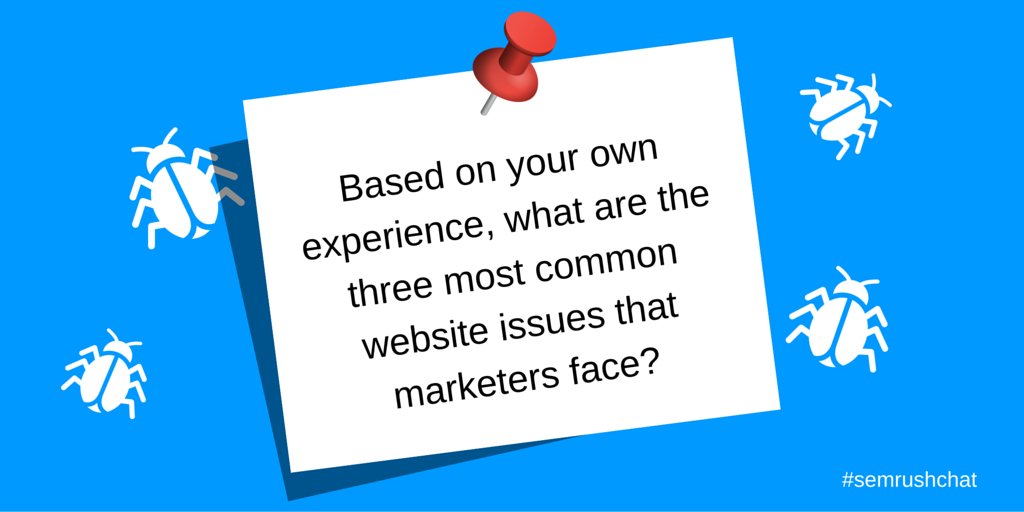
The list is long, but almost all of our participants pointed to three main reasons for penalties and poor overall performance.
A7: 1. Poor site architecture/design. 2. Not technically optimized (pagespeed, microdata). 3. Too many cooks in the kitchen #semrushchat
— Lee Germeroth (@leegermeroth) 20 января 2016
To avoid them, put the user first, spend some time analyzing your site’s speed and improving it (by preparing all images for both the Web and mobile, for example), and delegate the job to one person or take on all the responsibility yourself.
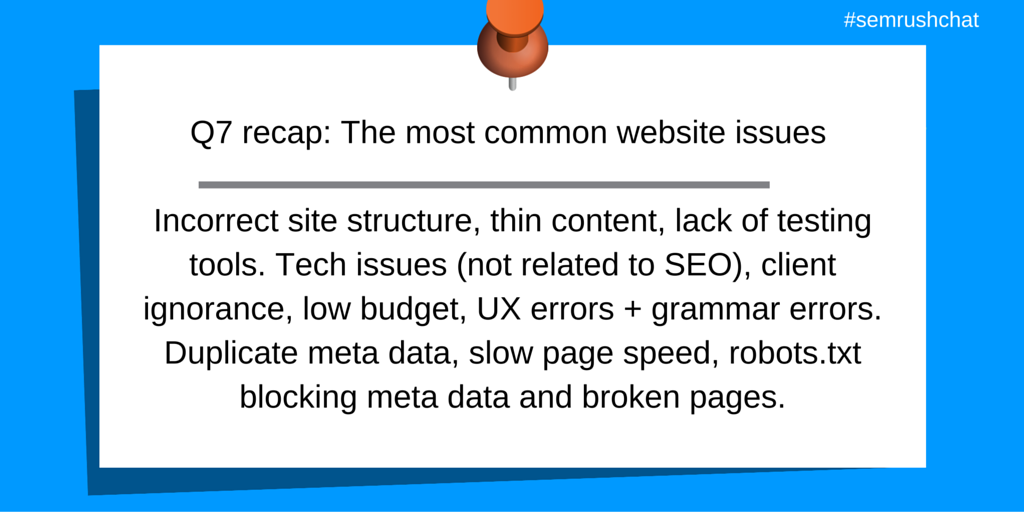
Well, it’s time to wrap up, but we’ve only touched the tip of the iceberg when it comes to optimizing the perfect website for search engines. Thanks to Laurent and all of today’s participants for sharing your expertise with us.
Don’t forget to join our SEMrush Chat next Wednesday and share your homegrown recipes for creating a perfectly optimized website in the comments section.
Innovative SEO services
SEO is a patience game; no secret there. We`ll work with you to develop a Search strategy focused on producing increased traffic rankings in as early as 3-months.
A proven Allinclusive. SEO services for measuring, executing, and optimizing for Search Engine success. We say what we do and do what we say.
Our company as Semrush Agency Partner has designed a search engine optimization service that is both ethical and result-driven. We use the latest tools, strategies, and trends to help you move up in the search engines for the right keywords to get noticed by the right audience.
Today, you can schedule a Discovery call with us about your company needs.
Source:




![How To Create a Strategic Dashboard in Excel Using Semrush Data [Excel Template Included]](https://new.allinclusive.agency/uploads/images/how-to-create-a-strategic-dashboard-in-excel-using-semrush-data-excel-template-included.svg)
